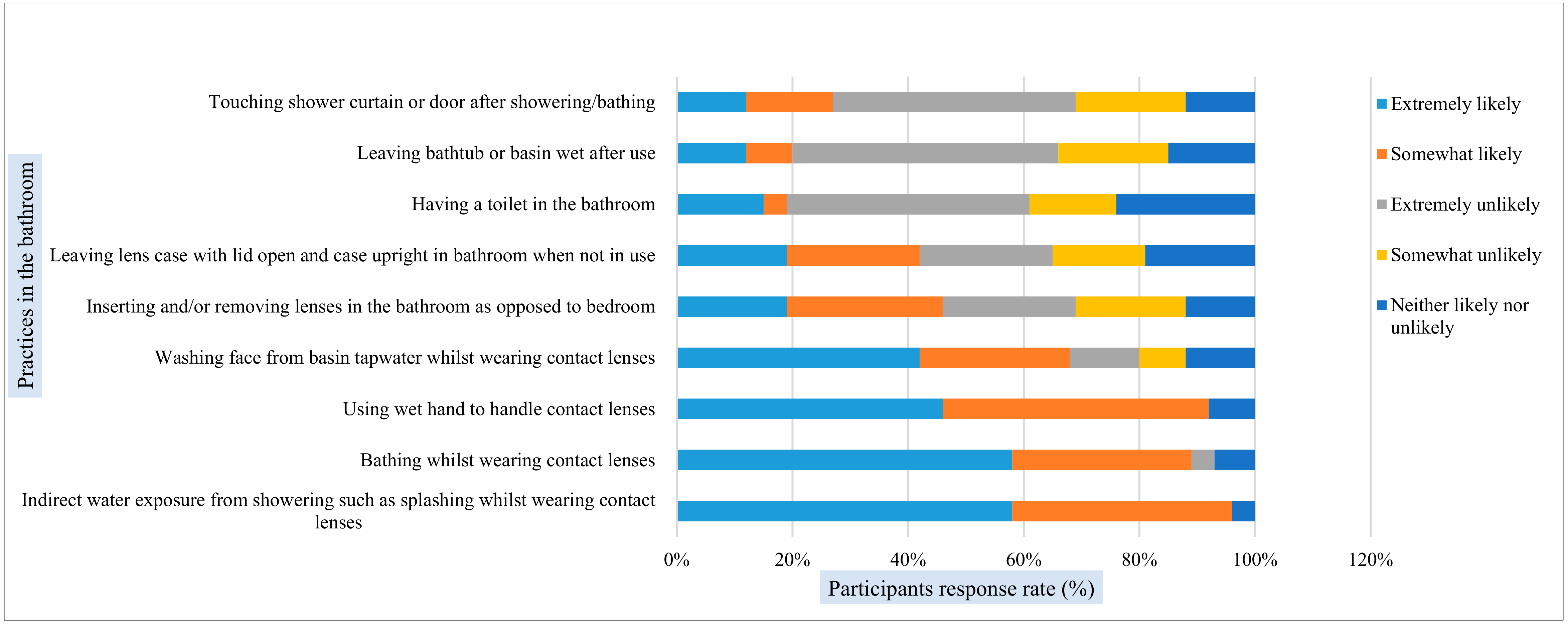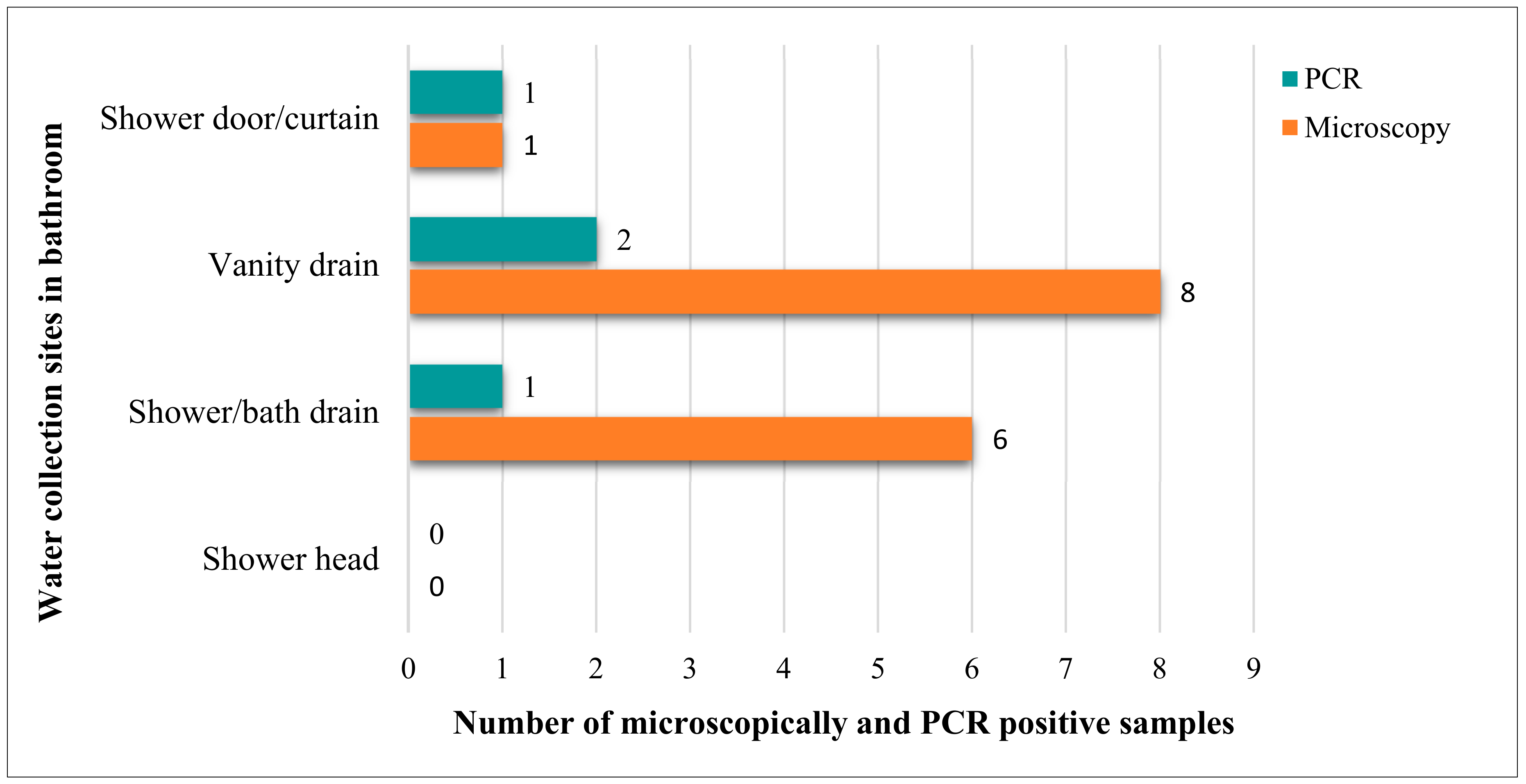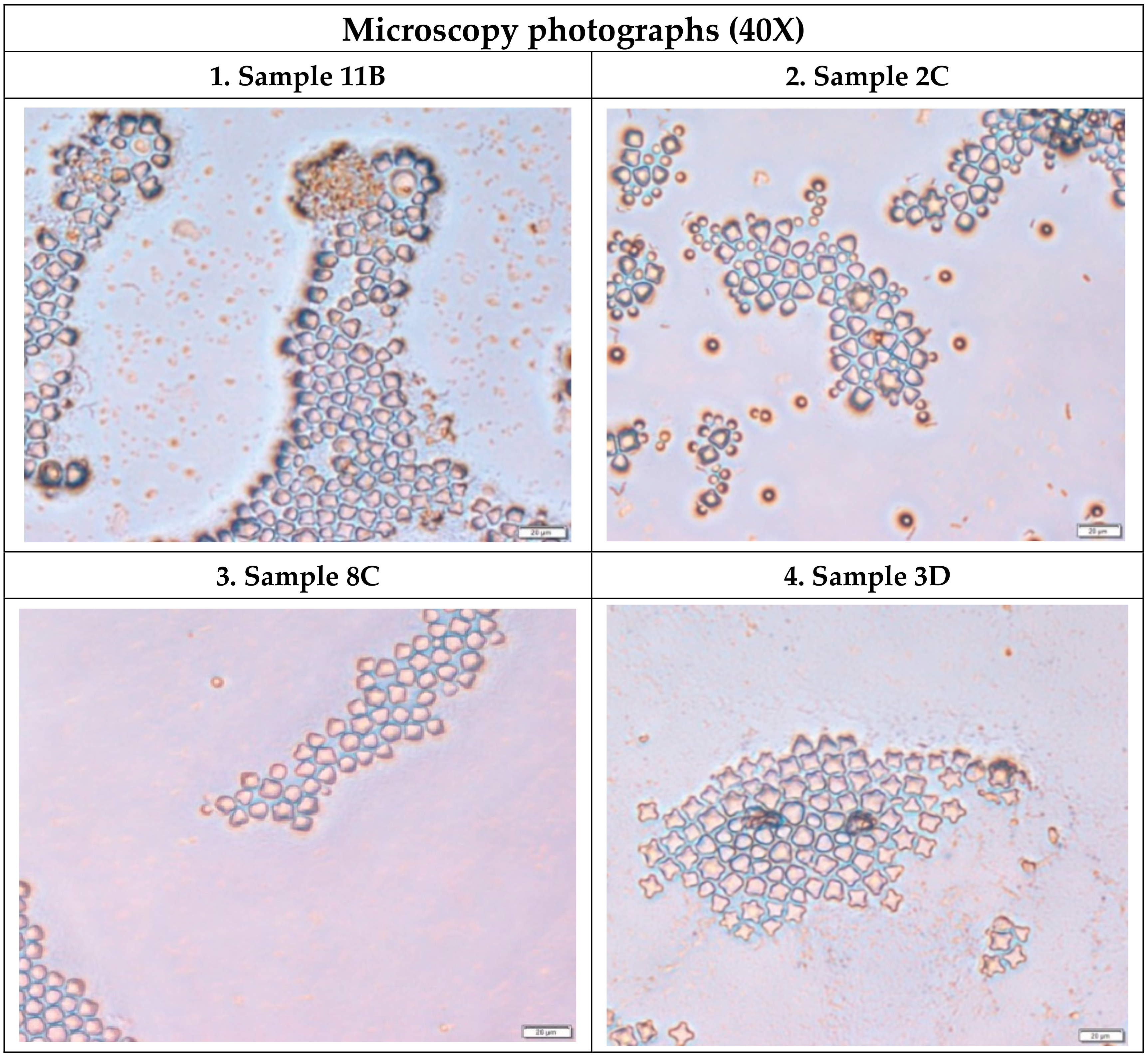Investigating Domestic Shower Settings as a Risk Factor for Acanthamoeba Keratitis
Abstract
1. Introduction
2. Methods
2.1. Study Design
2.1.1. Phase I
2.1.2. Phase II
2.2. Sample Collection
2.3. Culture and Microscopic Analysis
2.4. PCR Amplification and Sequencing
2.5. Phylogenetic Reconstruction
3. Results
3.1. Survey Questionnaire (Phase I)
3.2. Detection of Acanthamoeba spp. in Collected Samples (Phase II)
4. Discussion
5. Conclusions
Supplementary Materials
Author Contributions
Funding
Acknowledgments
Conflicts of Interest
Abbreviation
| AK | Acanthamoeba keratitis |
| BLAST | Basic local alignment search tool |
| CL | Contact lens |
| FLA | Free living amoeba |
| MPS | Multipurpose solution |
Appendix A. Online Questionnaire Posted on Acanthamoeba Keratitis Facebook Group

References
- Visvesvara, G.S.; Moura, H.; Schuster, F.L. Pathogenic and opportunistic free-living amoebae: Acanthamoeba spp., Balamuthia mandrillaris, Naegleria fowleri, and Sappinia diploidea. FEMS Immunol. Med. Microbiol. 2007, 50, 1–26. [Google Scholar] [CrossRef]
- Siddiqui, R.; Khan, N.A. Biology and pathogenesis of Acanthamoeba. Parasit Vectors 2012, 5, 6. [Google Scholar] [CrossRef]
- Schuster, F.L. Cultivation of pathogenic and opportunistic free-living amebas. Clin. Microbiol. Rev. 2002, 15, 342–354. [Google Scholar] [CrossRef]
- Marciano-Cabral, F.; Cabral, G.J. Acanthamoeba spp. as agents of disease in humans. Clin. Microbiol. Rev. 2003, 16, 273–307. [Google Scholar] [CrossRef] [PubMed]
- Neelam, S. Pathobiology and immunobiology of Acanthamoeba keratitis: Insights from animal models. Yale J. Biol. Med. 2017, 90, 261–268. [Google Scholar] [PubMed]
- Pussard., M.; Pons, R. Morphologies of the cystic wall and taxonomy of the genus Acanthamoeba (Protozoa, Amoebida). Protistologica 1977, 13, 557–610. [Google Scholar]
- Corsaro, D.; Walochnik, J.; Köhsler, M.; Rott, M.B. Acanthamoeba misidentification and multiple labels: Redefining genotypes T16, T19, and T20 and proposal for Acanthamoeba micheli sp. nov.(genotype T19). Parasitol. Res. 2015, 114, 2481–2490. [Google Scholar] [CrossRef]
- Taher, E.E.; Méabed, E.M.; Abdallah, I.; Wahed, W.Y.A. Acanthamoeba keratitis in noncompliant soft contact lenses users: Genotyping and risk factors, a study from Cairo, Egypt. J. Infect. Public Health 2018, 11, 377–383. [Google Scholar] [CrossRef]
- Orosz, E.; Szentmáry, N.; Kiss, H.J.; Farkas, Á.; Kucsera, I.; Nagy, Z.Z. First report of Acanthamoeba genotype T8 human keratitis. Acta Microbiol. Immunol. Hung. 2018, 65, 73–79. [Google Scholar] [CrossRef]
- Grün, A.L.; Stemplewitz, B.; Scheid, P. First report of an Acanthamoeba genotype T13 isolate as etiological agent of a keratitis in humans. Parasitol. Res. 2014, 113, 2395–2400. [Google Scholar] [CrossRef]
- Stehr-Green, J.K.; Bailey, T.M.; Visvesvara, G.S. The epidemiology of Acanthamoeba keratitis in the United States. Am. J. Ophthalmol. 1989, 107, 331–336. [Google Scholar] [CrossRef]
- Por, Y.M.; Mehta, J.S.; Chua, J.L.; Koh, T.H.; Khor, W.B.; Fong, A.C.; Lim, J.W.; Heng, W.J.; Loh, R.S.; Lim, L.J. Acanthamoeba keratitis associated with contact lens wear in Singapore. Am. J. Ophthalmol. 2009, 148, 7–12. [Google Scholar] [CrossRef] [PubMed]
- Lindsay, R.G.; Watters, G.; Johnson, R.; Ormonde, S.E.; Snibson, G.R.J.C.; Optometry, E. Acanthamoeba keratitis and contact lens wear. Clin. Exp. Optom. 2007, 90, 351–360. [Google Scholar] [CrossRef]
- Radford, C.; Minassian, D.; Dart, J.J. Acanthamoeba keratitis in England and Wales: Incidence, outcome, and risk factors. Br. J. Ophthalmol. 2002, 86, 536–542. [Google Scholar] [CrossRef] [PubMed]
- Stehr-Green, J.K.; Bailey, T.M.; Brandt, F.H.; Carr, J.H.; Bond, W.W.; Visvesvara, G.S. Acanthamoeba keratitis in soft contact lens wearers: A case-control study. JAMA 1987, 258, 57–60. [Google Scholar] [CrossRef] [PubMed]
- Carnt, N.; Hoffman, J.J.; Verma, S.; Hau, S.; Radford, C.F.; Minassian, D.C.; Dart, J.K. Acanthamoeba keratitis: Confirmation of the UK outbreak and a prospective case-control study identifying contributing risk factors. Br. J. Ophthalmol. 2018, 102, 1621–1628. [Google Scholar] [CrossRef] [PubMed]
- Joslin, C.E.; Tu, E.Y.; Shoff, M.E.; Booton, G.C.; Fuerst, P.A.; McMahon, T.T.; Anderson, R.J.; Dworkin, M.S.; Sugar, J.; Davis, F.G.J. The association of contact lens solution use and Acanthamoeba keratitis. Am. J. Ophthalmol. 2007, 144, 169–180. [Google Scholar] [CrossRef]
- Verani, J.R.; Lorick, S.A.; Yoder, J.S.; Beach, M.J.; Braden, C.R.; Roberts, J.M.; Conover, C.S.; Chen, S.; McConnell, K.A.; Chang, D.C.; et al. National outbreak of Acanthamoeba keratitis associated with use of a contact lens solution, United States. Emerg. Infect. Dis. 2009, 15, 1236. [Google Scholar] [CrossRef]
- Carnt, N.A.; Subedi, D.; Lim, A.W.; Lee, R.; Mistry, P.; Badenoch, P.R.; Kilvington, S.; Dutta, D.J.C.; Optometry, E. Prevalence and seasonal variation of Acanthamoeba in domestic tap water in greater Sydney, Australia. Clin. Exp. Optom. 2020, 103, 782–786. [Google Scholar] [CrossRef]
- Kilvington, S.; Gray, T.; Dart, J.; Morlet, N.; Beeching, J.R.; Frazer, D.G.; Matheson, M. Acanthamoeba keratitis: The role of domestic tap water contamination in the United Kingdom. Investig. Ophthalmol. Vis. Sci. 2004, 45, 165–169. [Google Scholar] [CrossRef]
- Robertson, D.M.; Cavanagh, H.D. Non-compliance with contact lens wear and care practices: A comparative analysis. Optom. Vis. Sci. 2011, 88, 1402. [Google Scholar] [CrossRef] [PubMed]
- Carnt, N.; Stapleton, F. Strategies for the prevention of contact lens-related Acanthamoeba keratitis: A review. Ophthalmic Physiol. Opt. 2016, 36, 77–92. [Google Scholar] [CrossRef] [PubMed]
- Carnt, N.A.; Subedi, D.; Connor, S.; Kilvington, S.J. The relationship between environmental sources and the susceptibility of Acanthamoeba keratitis in the United Kingdom. PLoS ONE 2020, 15, e0229681. [Google Scholar] [CrossRef] [PubMed]
- Stapleton, F.; Keay, L.J.; Sanfilippo, P.G.; Katiyar, S.; Edwards, K.P.; Naduvilath, T.J. Relationship between climate, disease severity, and causative organism for contact lens–associated microbial keratitis in Australia. Am. J. Ophthalmol. 2007, 144, 690–698. [Google Scholar] [CrossRef] [PubMed]
- Carrijo-Carvalho, L.C.; Sant’ana, V.P.; Foronda, A.S.; de Freitas, D.; de Souza Carvalho, F.R. Therapeutic agents and biocides for ocular infections by free-living amoebae of Acanthamoeba genus. Surv. Ophthalmol. 2017, 62, 203–218. [Google Scholar] [CrossRef]
- Lorenzo-Morales, J.; Khan, N.A.; Walochnik, J.J. An update on Acanthamoeba keratitis: Diagnosis, pathogenesis and treatment. Parasite 2015, 22, 10. [Google Scholar] [CrossRef]
- Carnt, N.; Robaei, D.; Minassian, D.C.; Dart, J.K.G. Acanthamoeba keratitis in 194 patients: Risk factors for bad outcomes and severe inflammatory complications. Br. J. Ophthalmol. 2018, 102, 1431–1435. [Google Scholar] [CrossRef]
- Australian Bureau of Statistics. 2008 Year Book Australia No. 90; Australian Bureau of Statistics: Canberra, Australia, 2008.
- Kilvington, S.; Larkin, D.; White, D.; Beeching, J.R. Laboratory investigation of Acanthamoeba keratitis. J. Clin. Microbiol. 1990, 28, 2722–2725. [Google Scholar] [CrossRef]
- Iovieno, A.; Miller, D.; Lonnen, J.; Kilvington, S.; Alfonso, E.C. Extraction of Acanthamoeba DNA by use of Chelex resin. J. Clin. Microbiol. 2011, 49, 476–477. [Google Scholar] [CrossRef]
- Lorenz, T. Polymerase chain reaction: Basic protocol plus troubleshooting and optimization strategies. J. Vis. Exp. 2012, 63, e3998. [Google Scholar] [CrossRef] [PubMed]
- Behera, H.S.; Satpathy, G.; Tripathi, M. Isolation and genotyping of Acanthamoeba spp. from Acanthamoeba meningitis/meningoencephalitis (AME) patients in India. Parasites Vectors 2016, 9, 442. [Google Scholar] [CrossRef] [PubMed]
- Guindon, S.; Dufayard, J.F.; Lefort, V.; Anisimova, M.; Hordijk, W.; Gascuel, O. New algorithms and methods to estimate maximum-likelihood phylogenies: Assessing the performance of PhyML 3.0. Syst. Biol. 2010, 59, 307–321. [Google Scholar] [CrossRef] [PubMed]
- Letunic, I.; Bork, P. Interactive Tree Of Life (iTOL): An online tool for phylogenetic tree display and annotation. Bioinformatics 2007, 23, 127–128. [Google Scholar] [CrossRef] [PubMed]
- Joslin, C.E.; Tu, E.Y.; McMahon, T.T.; Passaro, D.J.; Stayner, L.T.; Sugar, J.J. Epidemiological characteristics of a Chicago-area Acanthamoeba keratitis outbreak. Am. J. Ophthalmol. 2006, 142, 212–217. [Google Scholar] [CrossRef] [PubMed]
- Koltas, I.S.; Eroglu, F.; Erdem, E.; Yagmur, M.; Tanır, F. The role of domestic tap water on Acanthamoeba keratitis in non-contact lens wearers and validation of laboratory methods. Parasitol. Res. 2015, 114, 3283–3289. [Google Scholar] [CrossRef]
- Zimmerman, A.B.; Richdale, K.; Mitchell, G.L.; Kinoshita, B.T.; Lam, D.Y.; Wagner, H.; Sorbara, L.; Chalmers, R.L.; Collier, S.A.; Cope, J.R. Water exposure is a common risk behavior among soft and gas-permeable contact lens wearers. Cornea 2017, 36, 995–1001. [Google Scholar] [CrossRef]
- Ibrahim, Y.W.; Boase, D.L.; Cree, I.A. How could contact lens wearers be at risk of Acanthamoeba infection? A review. J. Optom. 2009, 2, 60–66. [Google Scholar] [CrossRef]
- Stockman, L.J.; Wright, C.J.; Visvesvara, G.S.; Fields, B.S.; Beach, M.J. Prevalence of Acanthamoeba spp. and other free-living amoebae in household water, Ohio, USA—1990–1992. Parasitol. Res. 2011, 108, 621–627. [Google Scholar] [CrossRef]
- Boost, M.; Cho, P.; Lai, S.; Sun, W.M. Detection of Acanthamoeba in tap water and contact lens cases using polymerase chain reaction. Investig. Ophthalmol. Vis. Sci. 2008, 85, 526–530. [Google Scholar] [CrossRef]
- WaterNSW. Drinking Water Quality Report, 2018–2019; Water NSW: Parramatta, NSW, Asutralia, 2019. [Google Scholar]
- Corporation, S.W. South Australian Water Corporation Annual Report, 2018–2019; Water NSW: Parramatta, NSW, Asutralia, 2019. [Google Scholar]
- Utilities, U. Drinking Water Quality Management Plan Report for 2018/19. Available online: https://urbanutilities.com.au/residential/help-and-advice/drinking-water-quality (accessed on 15 October 2020).
- Gatti, S.; Rama, P.; Matuska, S.; Berrilli, F.; Cavallero, A.; Carletti, S.; Bruno, A.; Maserati, R.; Di Cave, D. Isolation and genotyping of Acanthamoeba strains from corneal infections in Italy. J. Med Microbiol. 2010, 59, 1324–1330. [Google Scholar] [CrossRef] [PubMed]
- Jercic, M.I.; Aguayo, C.; Saldarriaga-Córdoba, M.; Muiño, L.; Chenet, S.M.; Lagos, J.; Osuna, A.; Fernández, J. Genotypic diversity of Acanthamoeba strains isolated from Chilean patients with Acanthamoeba keratitis. Parasites Vectors 2019, 12, 58. [Google Scholar] [CrossRef] [PubMed]
- Shokri, A.; Sarvi, S.; Daryani, A.; Sharif, M.J.T. Isolation and genotyping of Acanthamoeba spp. as neglected parasites in north of Iran. Korean J. Parasitol. 2016, 54, 447–453. [Google Scholar] [CrossRef] [PubMed]
- Niyyati, M.; Lorenzo-Morales, J.; Rezaie, S.; Rahimi, F.; Martín-Navarro, C.M.; Mohebali, M.; Maghsood, A.H.; Farnia, S.; Valladares, B.; Rezaeian, M. First report of a mixed infection due to Acanthamoeba genotype T3 and Vahlkampfia in a cosmetic soft contact lens wearer in Iran. Exp. Parasitol. 2010, 126, 89–90. [Google Scholar] [CrossRef] [PubMed]
- Arnalich-Montiel, F.; Lumbreras-Fernández, B.; Martín-Navarro, C.M.; Valladares, B.; Lopez-Velez, R.; Morcillo-Laiz, R.; Lorenzo-Morales, J. Influence of Acanthamoeba genotype on clinical course and outcomes for patients with Acanthamoeba keratitis in Spain. J. Clin. Microbiol. 2014, 52, 1213–1216. [Google Scholar] [CrossRef] [PubMed]
- Maghsood, A.H.; Sissons, J.; Rezaian, M.; Nolder, D.; Warhurst, D.; Khan, N.A. Acanthamoeba genotype T4 from the UK and Iran and isolation of the T2 genotype from clinical isolates. J. Med. Microbiol. 2005, 54, 755–759. [Google Scholar] [CrossRef]
- Ledee, D.; Iovieno, A.; Miller, D.; Mandal, N.; Diaz, M.; Fell, J.; Fini, M.; Alfonso, E. Molecular identification of T4 and T5 genotypes in isolates from Acanthamoeba keratitis patients. J. Clin. Microbiol. 2009, 47, 1458–1462. [Google Scholar] [CrossRef]
- Shoff, M.; Rogerson, A.; Schatz, S.; Seal, D. Variable responses of Acanthamoeba strains to three multipurpose lens cleaning solutions. Investig. Ophthalmol. Vis. Sci. 2007, 84, 202–207. [Google Scholar] [CrossRef]




Publisher’s Note: MDPI stays neutral with regard to jurisdictional claims in published maps and institutional affiliations. |
© 2020 by the authors. Licensee MDPI, Basel, Switzerland. This article is an open access article distributed under the terms and conditions of the Creative Commons Attribution (CC BY) license (http://creativecommons.org/licenses/by/4.0/).
Share and Cite
Rayamajhee, B.; Subedi, D.; Won, S.; Kim, J.; Vijay, A.; Tan, J.; Henriquez, F.L.; Willcox, M.; Carnt, N.A. Investigating Domestic Shower Settings as a Risk Factor for Acanthamoeba Keratitis. Water 2020, 12, 3493. https://doi.org/10.3390/w12123493
Rayamajhee B, Subedi D, Won S, Kim J, Vijay A, Tan J, Henriquez FL, Willcox M, Carnt NA. Investigating Domestic Shower Settings as a Risk Factor for Acanthamoeba Keratitis. Water. 2020; 12(12):3493. https://doi.org/10.3390/w12123493
Chicago/Turabian StyleRayamajhee, Binod, Dinesh Subedi, Seoyoung Won, Jamie (Jung Yun) Kim, Ajay Vijay, Jacqueline Tan, Fiona L. Henriquez, Mark Willcox, and Nicole A. Carnt. 2020. "Investigating Domestic Shower Settings as a Risk Factor for Acanthamoeba Keratitis" Water 12, no. 12: 3493. https://doi.org/10.3390/w12123493
APA StyleRayamajhee, B., Subedi, D., Won, S., Kim, J., Vijay, A., Tan, J., Henriquez, F. L., Willcox, M., & Carnt, N. A. (2020). Investigating Domestic Shower Settings as a Risk Factor for Acanthamoeba Keratitis. Water, 12(12), 3493. https://doi.org/10.3390/w12123493







